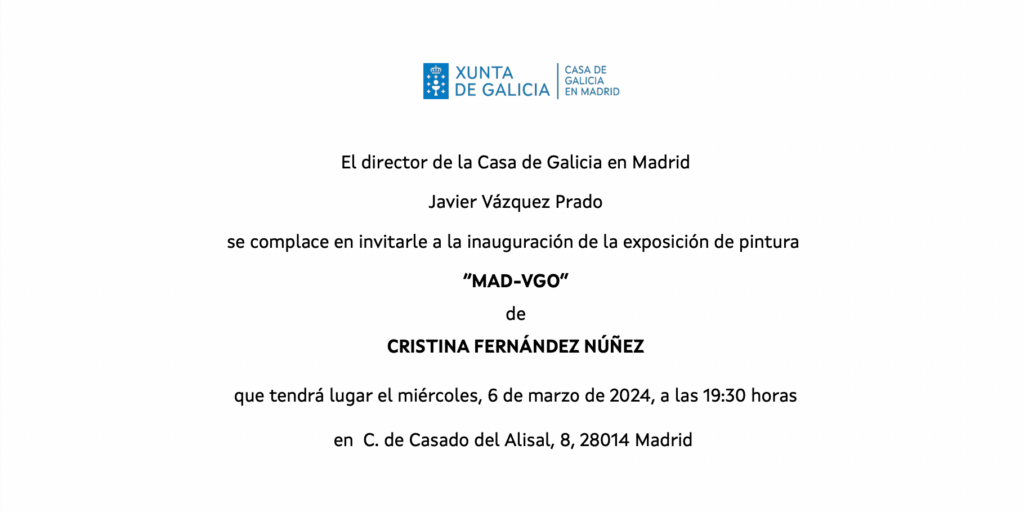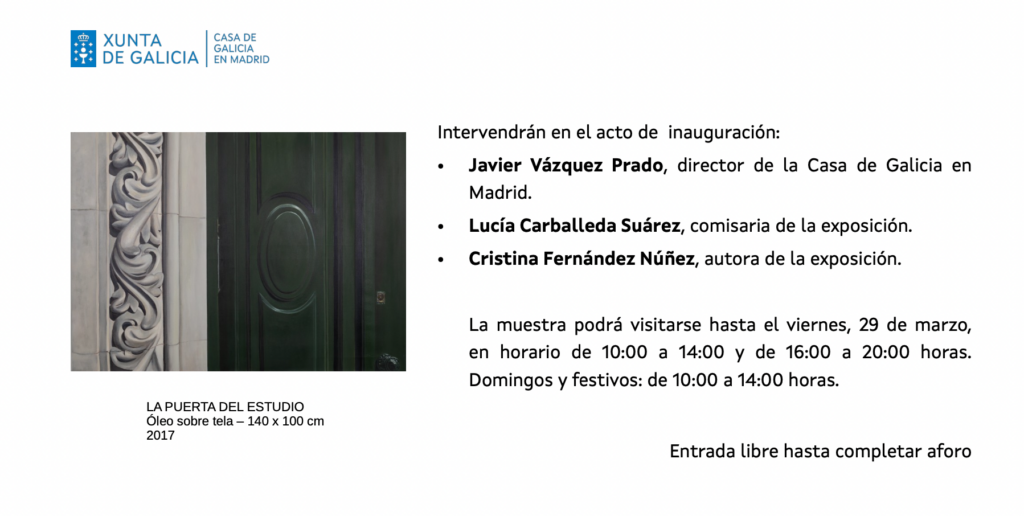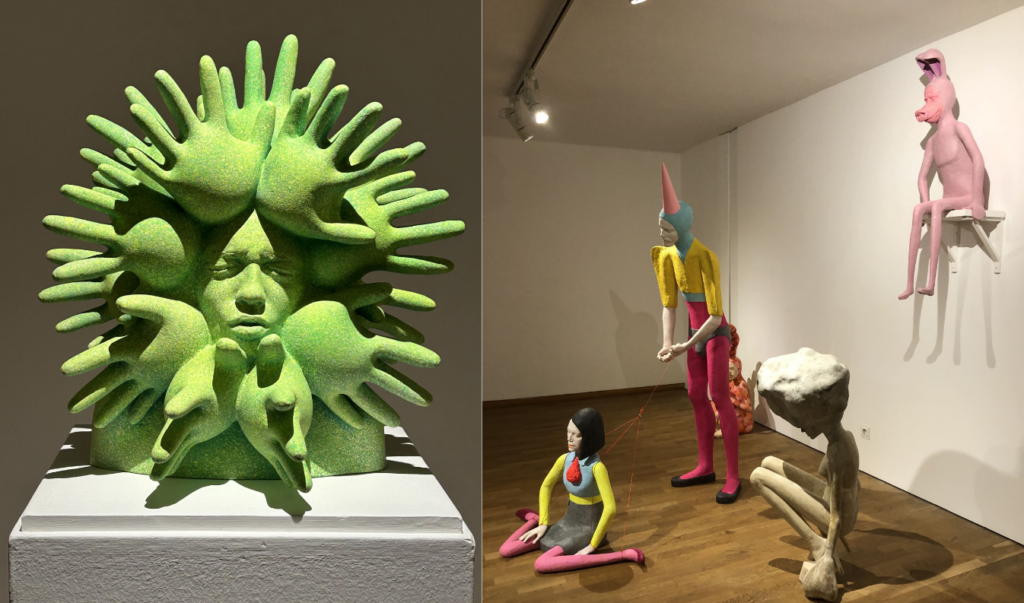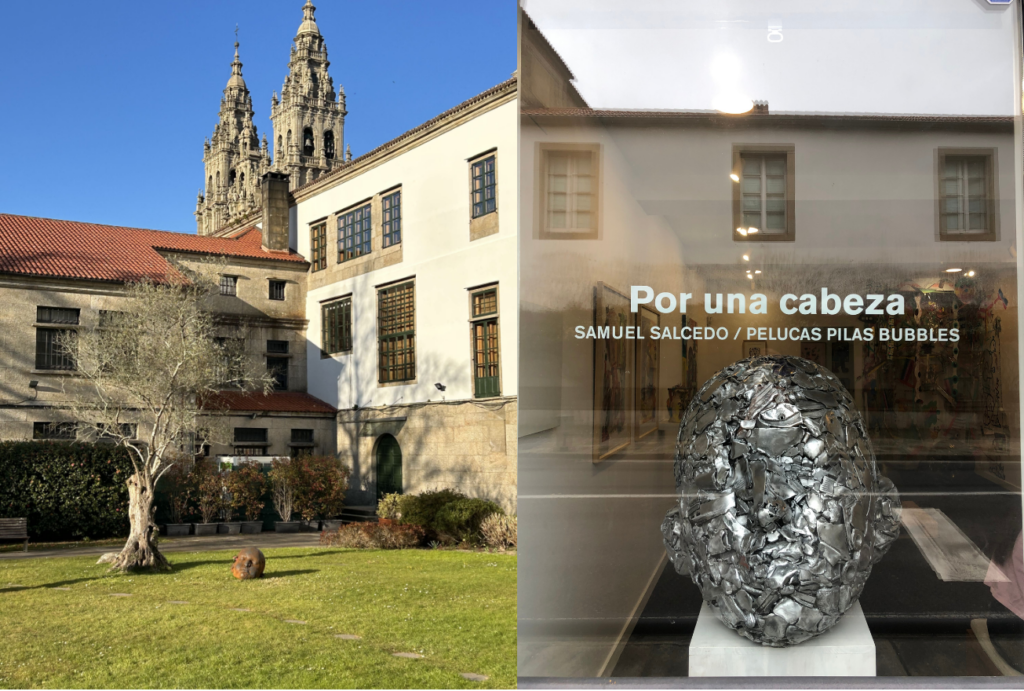VGO – MAD
Cristina Fernández Núñez- Casa de Galicia, 6 March 2024


“We cannot imagine how powerful the idea of travel would be…”
Simone Weil
If it’s not possible to understand the work of Cristina Fernandez Nunez without the concept of travel, then neither is it understandable without the concept of movement. We find it in the rhythm of her paintings, in the straight lines and curves that coexist in her facades, the transit of a cloud that starts to escape from the plane, or in the way she captures on the canvas a ray of light that is about to expire. Sometimes, the time runs in Cristina’s paintings with the speed of a frame that she captures for us. She has memorized it in her retina while she traveled by train, eyes glued to the window, absorbed in the landscape like those who go to the movie theater.
The symbolic component is another one of her identifying features. The door, threshold of excellence in Art History, between the profane and sacred, is also present here. Cristina shows us the detail of a green door carved from wood, with one of its flanks in carved stone with plant motifs. Not only does it result in the wondering of what is hidden behind it, but it also narrates to perfection the duality of the artist when it comes to representing the landscape. It’s not accidental that Cristina’s eye stops, when she’s representing an urban landscape, at a molding where garlands and other plant figures surface. All these organic forms, chiseled into stone of an embellished mural or arabesques forged in iron framing the opening of an entrance, respond to a search of nature within the urban landscape. In the same way, when she undertakes the representation of a natural scenery, she searches for a straight line time and time again. And she always finds it: in the horizon, or in text (normally in French) that passes through the landscape.
It is said that landscape is memory. In her book Mysteries of the Rectangle, Siri Hustvedt describes to us how “a painting creates an illusion of an eternal present, a place where [our] eyes can rest as if the clock has magically stopped ticking.” The rectangle of the canvas becomes a window open to the world, where the painter presents themself. For Cristina, it’s additionally the frame where to breathe oxygen, where to ask for help, where to find peace. Gone are the university years of painting, in the city of the Bear and the Strawberry Tree, when she would go back and forth by train from Vigo to Madrid while she studied Fine Arts. Perhaps this is why she continues to immortalize the architecture of this city, because it doesn’t exist over time.
INSANITY
Iván Prieto – Eugenio Granell Foundation, 16 February – 9 April 2023

Disturbing, moving and dreamlike. The visual arts of Iván Prieto (O Barco de Valdeorras 1978) has been compared with the work of Juan Muñoz -because of the uneasiness that is capable of transmitting and the loneliness of his characters-, with the photography of the Austrian Diane Arbus -with who shares a taste for the freak- or the movie characters of David Lynch. It is known that Prieto uses the features of people close to him as a starting point for the elaboration of many of his sculptures, an aspect that has led critics to compare him with George Seagal, who also uses moulds. On the other hand, the frozen poses of his characters and his sense of installation have linked him to Erwin Wurm.
These similarities contextualize the work of Iván Prieto in an international orbit, who also finds here, in his native Galicia, a very close referent such as Eugenio Granell. Both start from the creative freedom demanded by surrealism, escaping from the corset of reality and recreating their own universe. One, where women have a very prominent role as evidenced in this sample. Prieto’s tightrope walkers are a constant throughout his career, alluding to a perpetual state “on the wire”, as he himself maintains. Women with rounded shapes like “Pumpkin Girl” but also geometric, in “Geometric twins” we find an outstanding formal parallelism with the sculpture of Eugenio Granell (think of “La dama de Fontainebleau”). Some busts of the sculptor from Ourense, such as “Pájaros en la cabeza”, recall us the taste of surrealism for the liberation of the subconscious and at the same time remind us of one of the most Granellian characters, the bird-woman.
When the characters represented are male, we find in both artists a strong tendency towards androgynous beings, a Surrealist debt of Platonic influence, and in the specific case of Iván Prieto, almost always with painted lips. In this sense, the character of “Ícaro” stands out, one of the most self-referential sculptures from Ourense. This mythological figure is a tribute to the fragility that the sculptor carried out when he lived in Berlin, where the change of scene triggered severe asthmatic attacks in him, an aspect that ended up being reflected in his work. This is how the inflatables are born, characters that deflate, suffocated by a hostile environment.
If theatre was important in Granell’s work, in Ivan Prieto’s emotions take the form of disguise. Often the characters of the orensano are rabbits or a hybrid between the human and the animal. Masks that work as parapets used by their figures to bear reality. Here we are witnessing an installation starring puppets with hieratic and colourful characters, unable to smile.
Today, the concept of style has been overcome and dissolved, and far from pigeonholing the artistic language of Iván Prieto, his work shows an incessant quest to circumvent the conscious faculties. It is also palpable in his way of approaching matter, a kind of meditation where he tends to replicate elements automatically. This is reflected in his work “Craziness”, a ceramic made by a cluster of hands, as if each palm were a thought. A disguise, a trance, a frowning green neurosis.
BY A HEAD
Samuel Salcedo y Pelucas Pilas Bubbles – (urban intervention, Fonseca Garden), 10 February – 24 April 2023

“By a Head” is the chosen name for this exhibition that not only makes reference to the sculpture of these artists, but also appeals in a symbolic manner to the figure of the apostle (whose body guarded in the cathedral’s crypt is missing its head due to decapitation) and to its equestrian representation, since the expression “by a head” is also an equestrian term. To all of this, one must add the fact that Santiago is the cultural head of Galicia, an aspect that the exhibition (both from the art gallery and from the street) would be emphasizing.
Taking the Dupla Gallery as a starting point, the works of the artists take to the streets. In particular, through an installation by Samuel Salcedo in the Garden of Fonseca of “las pedras que falan” (written in Galician, meaning “stones that talk”), after an agreement with the University and the Council of Santiago. This location is closely related to the plastic concept of the Catalan sculptor, who conceives his pieces as an species of song, as he revealed in his urban intervention at the Center of Art Tomás y Valiente de Fuenlabrada (CEART), an exposition he called “Rolling Stones.”
This initiative seeks interaction with the viewer, bringing art closer to its residents.

